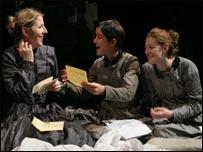Tuesday, September 13, 2005
9:57 pm by Anonymous

The following is a
review by Trevor Gibbons on the play Brontë on stage in Leeds from 6 September 2005 to 17 September 2005:
Looking now at the heritage theme park that is Haworth, visitors would do well to remember a couple of statistics mentioned early in this production.
According to Brontë, by Polly Teale, one in two children died before the age of 6 and the average life expectancy of a labourer in Haworth’s textile industry was 26 years in the mid 1800s.
This production makes it very clear we are watching a fiction. The three actresses that play the sisters come on as themselves and begin to put on the corsets, underskirts and dresses that will transport us back in time.
In an isolated childhood the three sisters (Anne, Emily and Charlotte) and their brother Branwell escaped into a world of make believe - inventing countries, heroes and heroines and committing many of these adventures to small home-produced books.
Despite it being a time of great social and industrial change the women were still constrained by the morals of the age that expected women to know, and stay in, their place. Despite dreams and ideas of writing, the women had to watch Branwell escape the confines of the parsonage to have a chance to shine.
Ultimately, despite having some works published. His escapades were to end in drunkenness, drug abuse, debt and death.
Even when the sisters’ stories were published it was under three (male) pseudonyms.
Mortality stalks the story, two Brontë sisters had died previously in childhood Anne, Branwell and Emily all died around the age of 30 years old and Charlotte succumbed to illness in the early stages of pregnancy just short of 39 years old. Tragically short lives that add to the enduring legend. These are the bare bones of the story but Teale manages to wring even more drama and tension out of the tragic story.
Obviously central to the story are the performances of Diane Beck (Emily), Catherine Cusack (Anne) and Fenella Woolgar (Charlotte) and it is great ensemble playing between the three, making the sisters truly human and very believable.
My favourite was Fenella Woolgar who brought a real, almost, matriarchal quality as the oldest sister. Matthew Thomas (Branwell) did well making a telling contribution even though his tale could have been merely peripheral to the sisters’ story.
A succession of characters are played by David Fielder, dramatically the main one is as the Reverend Brontë, sometimes he superbly slips between two different characters while on stage.
Much of the literary success of the sisters was through a collective imagination and Natalia Tena plays imaginary characters including Kathy from Wuthering Heights and most disturbingly the mad, sexually charged imagination of the outwardly subdued Charlotte.
I loved the story that suggested the publishers thought ‘wuthering’ too much of a dialect word and suggested the substitution of ‘windy’. Windy Heights, I think not.
In fact, despite the rigours of life, there is some warming humour in this production mainly because of the actors’ skill in producing empathetic characters.
Great use of props really bring together the hard life eked out on the edge of the moors but Anne, in particular, is always clear that for most of the inhabitants of Haworth life is harder.
Constant lighting and extinguishing of candles lead to tendrils of smoke drifting around the simple set, that strongly features large images by Paula Rego, these combine with the wisps of dry ice sinking through the windows to create a dream-like quality to the action.
Brontë fan or not – see this production and glimpse a disappeared Yorkshire that provided such a hot-house environment for a talented but cursed family.
Categories: Theatre









0 comments:
Post a Comment